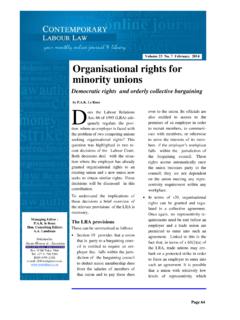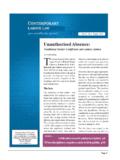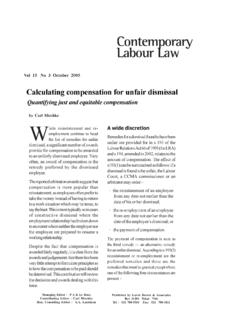Transcription of The extension of Bargaining Council agreements
1 Vol . 22 No. 8 March 2013. The extension of Bargaining Council agreements The Courts and challenges from non-parties by le Roux B. argaining Councils have a long permitted Black persons to become history in South African labour members were not permitted to law and industrial relations. The become parties to industrial councils. first industrial councils, the predecessors They were primarily institutions that to Bargaining councils, were established catered for the interests of skilled in the 1920's in terms of the Industrial White , Coloured and Asian . Conciliation Act of 1924.
2 Workers. In the 1970's, the period in which many The fourth was that collective if not most of the unions currently agreements entered into by the trade affiliated to COSATU have their unions and employers' organisations origins, industrial councils were the that were parties to the Council could primary collective Bargaining fora. They be extended to employers and had four important characteristics. employees who were not members of these trade unions or employers'. The first was that, as their name organisations. The power to extend indicated, the collective Bargaining that these agreements included the power took place within these bodies took place to extend them to Black workers.
3 At industry level. An industrial Council had jurisdiction over an industry as During the course of the late 1970's defined in its constitution. and early 1980's a series of legislative reforms which flowed from the The second was that, although these recommendations of the Wiehahn councils required the co-operation and Commission of Enquiry were consent of both organised employers introduced. The result was that trade Testnig and unions to be established, the process the Managing Editor: Le Roux of their establishment, and their powers fariness Contributing Editor: Carl Mischke and functions once established, were of Editor: Published by Gavin Brown & Associates regulated in detail by statute the po rmoitns Box 31380 Tokai 7966 Industrial Conciliation Act, 28 of 1956 What constitutes p46.
4 Tel: 021 788 5560. or its predecessors. a 'benefit'? p76. The third was that trade unions that Page 71. Contemporary Labour Law Vol 22 No 8 March 2013. unions catering for the interests of Black workers could be conciliated and arbitrated under their auspices. became entitled to join industrial councils. Bargaining councils have, in the intervening years, The initial reaction of these unions to this possibility grown in importance and have become one of the was ambivalent, to say the least. The opposition to central features of our industrial relations system. In this possibility was occasioned primarily by two recent years, however, increasing criticism has been considerations.
5 This first was pragmatic in that the expressed about one of the central features of these organisational focus of many of these unions was still bodies, namely their power to negotiate terms and that of recruiting workers in larger factories. Why conditions of employment, especially in the form of should they give up their power base in these large minimum wages and then, to have these terms and factories (where they were increasingly able to conditions of employment extended to the whole collectively bargain with the employers from a position industry over which they have jurisdiction.)
6 The of power) in favour of Bargaining at industry level argument has been that many councils are dominated where their representation and power was diluted? by the large employers and unions, and that they use The second was more ideological in nature in that their economic power to impose wages and other terms industrial councils were viewed with suspicion. Their and conditions of employment on smaller employers establishment and powers were based on statutes which the latter cannot afford thus reducing enacted by the Apartheid government and they were competition especially in industries already exposed to institutions from which these unions had been excluded the rigours of competition from low-wage countries.
7 By reason of the race of their members. This opposition and counter-arguments have been reflected in numerous newspaper articles and the However, as the membership and powers of these debate reflects divergent economic views and policy unions grew the attraction of joining industrial councils options. became evident. By negotiating a minimum wage at industrial Council level and then extending this agreement This contribution will not deal with these arguments to all employers and employees within the industry (and but will describe how these arguments have manifested perhaps retaining the power to negotiate wages in themselves in at least three sets of litigation.)
8 Brief excess of the minimum set at Council level with larger reference will also be made to the latest legal challenge employers) the interests of their members could be to be brought by the Free Market Foundation. catered for more efficiently. Before doing so, however, it is necessary to set out By the time that the current Labour Relations Act the legal framework found in s 32 of the LRA in terms was being negotiated under the auspices of the National of which agreements can be extended. Economic Development and Labour Council in the early 1990's these unions had become fervent The legal framework supporters of centralised Bargaining at industry level.
9 Section 32 prescribes a two stage process for the Indeed, COSATU proposed the establishment of an extension of collective agreements entered into by even more centralised system of collective Bargaining Bargaining councils. within councils with far wider jurisdictional scopes. The first step, prescribed by s 32(1), is that trade unions Although COSATU did not succeed in its wider aims, and employers' organisations that have entered into a the current Labour Relations Act, 66 of 1995 (LRA) collective agreement, and which therefore binds them states a clear preference for centralised Bargaining at and their members, may decide to request the Minister industry level though Bargaining councils - the of Labour to extend the agreement to employees and changed name reflecting the fact that these institutions employers that are not members of these unions and would also now operate in the public sector.
10 Employers' organisations. Certain representivity Bargaining councils were also given expanded dispute requirements are set for such decision to be valid. resolution functions in that unfair dismissal and unfair labour practice disputes falling within their jurisdiction Page 72. Contemporary Labour Law Vol 22 No 8 March 2013. The first involves a consideration of the Council itself, the second deals with the representivity of the trade unions that vote requirement of representivity of the parties in favour of a decision to request the to the Council within the industry over Minister to extend the agreement.










